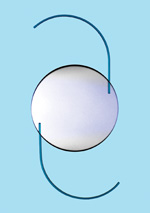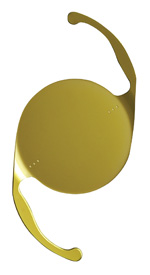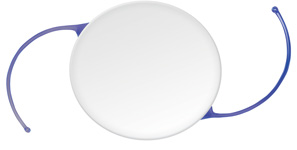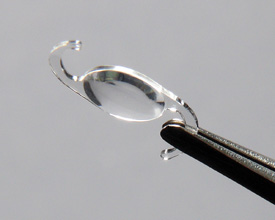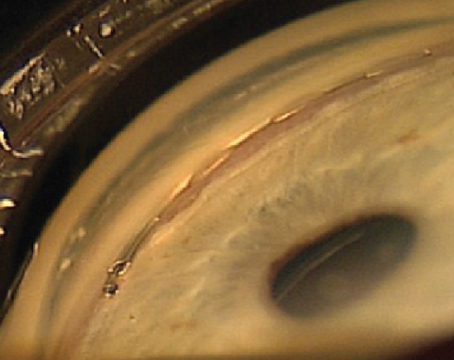The products that make the biggest promises get the most attention, as anyone who has marveled at the amount of information generated about multifocal and accommodating IOLs can attest. That being the case, in cataract surgery, monofocal intraocular lenses are so ubiquitous they’re almost taken for granted, yet they’re the lenses most of the patients who need cataract surgery are likely to get. Since 2010, four new monofocal intraocular lenses have been introduced in the United States, and surgeons have been gradually amassing experience with them, getting a feel for how to put their features to use in the operating room. Here, several surgeons experienced in the use of these IOLs discuss the new devices.
|
Aaren’s Enduring Clarity line of lenses is composed of two models, the EC-3 and the EC-3 Precision Aspheric Lens. Both are three-piece lenses made of a hydrophobic acrylic, with a square-edged optic to reduce the incidence of posterior capsule opacification. They each have a 6-mm optic and come in powers ranging from +4 to +34 D in 0.5-D increments.
According to the company, the bisign aspheric lens uses two different curvatures within the lens itself in order to balance out aberrations in the lens with misalignment, large pupils and different corneal shapes. The lens produces spherical aberration of an opposite sign in the central 3-mm zone vs. that in the periphery outside the central zone. The lens’s maker says that by having both positive and negative asphericity within the lens, it may be less impacted by a misalignment than if the asphericity was all one sign. “The lens balances out the aberrations so, in the presence of a lens misalignment or tilt, you’ll find a more consistent image quality, contrast sensitivity and expanded depth of focus,” says Kim Dyer, marketing manager for Aaren.
Venice, Fla., ophthalmologist P. Dee G. Stephenson took part in the Food and Drug Administration trial of the lens, and was pleased with how it performed. “Effective lens position is one of our big enemies when it comes to outcomes,” she says. “So, the asphericity characteristics of the lens are a big deal, because we don’t want to induce aberrations.”
In the multicenter FDA study, 354 subjects received the EC-3 lens in one eye and another monofocal in the fellow. At a year, 99 percent had a best-corrected vision of 20/40 or better. The most frequent adverse event was a 2-percent incidence of secondary surgical intervention for the following reasons: open operative sideport incision to relieve elevated intraocular pressure (0.6 percent); lens removal (0.6 percent); retinal detachment repair (0.3 percent); piggyback lens procedure (0.3 percent) and epiretinal membrane removal (0.3 percent). There was also a 1.1-percent incidence of cystoid macular edema in the study. Dr. Stephenson says her EC-3 patients are two years postop now and have no lens glistenings that some surgeons might be concerned about when considering an acrylic lens.
Dr. Stephenson says the three-piece design can be a boon to surgeons. “Being a three-piece lens is a big benefit,” she says. “Since it’s three-piece, this means if this is the go-to lens for a surgeon, she doesn’t need to have another lens around as a backup. She can use this lens and, after choosing the proper power, put it in the sulcus if she tears the bag since it’s not a one-piece.” In the study, the lens went through an average incision size of 2.9 mm.
“I was a silicone lens person for a long time,” Dr. Stephenson says. “So for me to try an acrylic lens was a big deal. In my arm of the EC-3 study, I inserted a silicone, three-piece, fourth-generation silicone IOL in the other eye of each of the 26 patients I operated on. I was surprised that the EC-3 performed as well as the three-piece silicone lens.”
Alcon’s High-correction Torics
Though many surgeons have been pleased with the AcrySof toric IOL, they been somewhat restricted by the limited range of correction the lenses had been approved for. This changed with the approval of the AcrySof IQ Toric for high ranges of correction. Specifically, this acrylic, single-piece lens is newly approved to treat corneal astigmatism ranges of 2.57 to 3.07 D (T6 model), 3.08 to 3.59 D (T7), 3.6 to
4.1 D (T8) and 4.11 D and higher (T9).
“The interesting thing is that people in the United States were interested in getting access to the high end of the toric correction range, but the majority of patients who would need a toric lens fall in the range of toric lenses that we’ve had available for a long time,” says Richard Tipperman, MD, assistant surgeon at the Cataract and Primary Eye Care Service at Wills Eye Institute.
“However, a lot of the advantage of the expanded toric range is that the idea of treating higher levels of astigmatism seems to make more sense to surgeons just starting with the technology. It might not make a lot of sense to some people to use a lens to treat 1 or 1.25 D of astigmatism. However, they know that if a patient has 2 to 4 D of astigmatism, if it’s left untreated the uncorrected vision is going to be very poor. So, for almost all surgeons, using the higher power toric intuitively makes more sense, and they’re more comfortable using it for that.
|
“The one thing a surgeon may encounter on occasion with higher power torics that isn’t always an issue with lower power toric lenses is the potential for ‘flipping’ or overcorrecting a patient,” Dr. Tipperman continues. “The way the lenses work, for every 10 degrees they’re off axis, you lose a third of the effect of the implant until, at 30-degrees misalignment, they’re effectively neutral in terms of astigmatism correction. But, if you implant a T3 toric, the lowest power available in the United States, and overcorrect the patient by 50 percent, the patient will only have 0.5 D of induced astigmatism 90 degrees away from where it was originally. However, if you do this with a T8 or T9, the patient will have 1.75 to 2 D of astigmatism oriented 90 degrees away from the original astigmatism, and that will be very manifest to him. So, it’s crucial that the axes line up.” (For a discussion of the finer points of implanting torics, see “37 Ways to Get Great Outcomes with Torics,” on p. 26.)
In the clinical study of the AcrySof toric, almost 90 percent of the lenses didn’t rotate or rotated only 5 degrees or less. However, Dr. Tipperman says there are situations where rotation can occur spontaneously. “Some surgeons have a feeling that very high myopes with very large anterior segments and very large capsular bags are at risk for spontaneous rotation,” he says. “In light of this, when faced with patients who are very nearsighted or who have high axial lengths, there are surgeons who will counsel them preoperatively, saying, ‘Look, this is the best lens for your nearsightedness and astigmatism. However, you’re aware that you have an unusual, very large eye. So, though this lens works well for everybody most of the time, even in highly nearsighted people, there’s a very small chance it will shift for you. If it does, though, there’s a way we can fix that.”
Hoya Optics iSymm Lens/iSert
The clear (as opposed to containing a yellow chromophore) iSymm IOL and the iSert pre-loaded inserter were actually marketed by Hoya for more than a year before the FDA requested that they be removed from the market in June 2011, pending the results of additional testing. Since then, the company has submitted that data, and signs look positive for the lens regaining its marketing status before February 2012, so it’s worth it for U.S. surgeons to be reacquainted with the IOL before it hits the market again. (The yellow version of the lens is currently available for sale.)
|
The -18 µm of negative asphericity in the lens is a product of a design Hoya calls the Aspheric Balanced Curve. In a lens with ABC, the central asphericity isn’t large enough to adversely affect visual quality when the lens is perfectly centered, yet can maintain the beneficial aspheric effect on vision with decentrations of up to 0.5 mm, the company says. In the periphery of the lens, the design resembles other negative aspheric IOLs.
The iSymm is intended to come preloaded in an injector system to decrease the amount of manipulation necessary to implant it. The lens and injector together are known as the iSert. “The benefit of preloading is that it’s done in an all-automated manufacturing process,” says Mr. Vander Zanden. “Because it’s truly preloaded, we think it’s a safer system because no one touches the lens before it’s in the patient’s eye. It’s always enclosed in the system, decreasing the likelihood of sterility issues, lens damage and exposure to contaminants that might cause toxic anterior segment syndrome. It also cuts out a lot of prep time by eliminating staff involvement in preparing the injector.” The iSert is designed to deliver the lens through a 2.2-mm incision.
Mr. Vander Zanden is optimistic about the FDA process. “We went to an independent lab and had the tests that the FDA required done again,” he says. “We’ve submitted the data and are now waiting for the FDA to give final comments and approval.”
Lenstec’s Softec HD
The Softec HD is a hydrophilic acrylic lens (26 percent water content) with an aspheric optic that offers powers in increments of 0.25 D in a certain power range [+18 to +25 D]. It is a clear lens, without any blue-blocking chromophore.
|
Dr. Moshirfar says that the lens can easily go through a 2.2- or 2.4-mm incision, though many surgeons use a 2.8-mm incision. “The process of folding it will be familiar to surgeons who’ve been working with these one-piece gummy lenses or one-piece acrylic lenses,” Dr. Moshirfar says. “There’s no real learning curve in terms of centration in the eye. As a hydrophilic lens, it’s got very good biocompatibility and has less of a chance of getting cloudy and developing glistenings, though at the same time it’s more resilient as you touch, manipulate and fold it. As it unfolds inside the eye, you don’t see creases in it.”
The other unique aspect of the Softec HD is its bi-aspheric design. “It has a symmetrical, bi-convex pattern from the anterior surface on one side to the posterior surface on the other,” explains Dr. Moshirfar. “Because of this, it’s a bit more forgiving when it comes to tilt, decentration and in terms of not creating coma or higher-order aberrations by itself. It has zero asphericity in total, meaning it doesn’t have a plus or minus magnitude on its own.”
After evaluating the lens’s specifications, some surgeons might question the optic size of 5.5 mm. Dr. Moshirfar understands this concern, but doesn’t think it’s warranted. “First, if you’re a surgeon used to doing a large capsulorhexis, I don’t think this will be any different for you. But if you’re used to making your capsulorhexis in the range of 5 mm or so, you may not have a problem with this because it’s still going to be completely covered 360 degrees around; the anterior capsule is still going to cover the IOL optic. I haven’t had photopsia issues, and I think it’s because of the lens’s symmetrical design, its water content and the fact that it’s more forgiving when it comes to tilt and decentration in the bag.”
Coming Attractions
Lens companies also have some designs that are either about to be studied in the United States or are already approved internationally and may arrive here in the future. Here is a rundown:
In September of 2011, Bausch + Lomb released the enVista hydrophobic acrylic IOL in Europe. The lens uses the company’s aberration-neutral Advanced Optics design in a material the company says is free of glistenings.
Rayner, which introduced the C-flex IOL in the United States in 2007, has a toric IOL that’s available internationally, the T-flex. The T-flex is available in standard astigmatism power ranges of +1 to +6 D. Also, in December 2011, the company received European approval for the Sulcoflex Multifocal Toric lens, which is designed to supplement a lens already in the bag in cases of unsatisfactory postop results.
For its part, Abbott Medical Optics launched the Tecnis Toric one-piece lens in Europe in 2011. The Tecnis Toric IOL has five models that are designed to treat different amounts of cylinder, from 0.69 D up to 2.74 D as measured at the corneal plane. The company says it’s currently working toward FDA approval of the lens in the United States.
Considering the lenses that have been recently approved and those in the pipeline, Dr. Moshirfar appreciates having so many options. “I think we should try to use all of the various platforms so we can learn from each of them,” he says.
